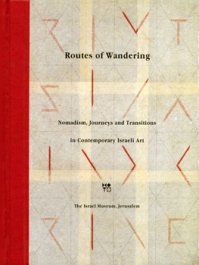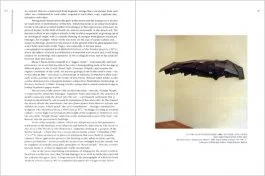Routes of Wandering
by Sarit Shapira
Michael Gitlin’s sculptures are characterized by Zalmona as “open and rickety, but also like shelters, and closed, generally unstable and with an appearance of temporariness, at times like references to mud and plank structures built by nomads or refugees, ‘Third World’ structures in their nature.” The centrality of the shelter can be seen in the names of the works: Temporary Shelter (1986), Vulnerable Cover (1986), Immediate Resoluteness (1987), Out of Place (1988). These works do not bound the defined area in its entirety — and the implicit completion of the boundary lines by the viewer is interfered with by means of other lines, that burst into the bounded space, fragmenting it, or not combining into one circumscribing pattern. With the bursting of the bounded areas there is generally an exposing of the lower, inner sides of the planks out of which the work is made. This externalization of the work’s “interior” as the other side of the external casing presents the inside of the work, its “heart,” as an additional gaze at artificial making. The empty space produced with the bursting of the lines that bound the space in which the sculpture is erected endows the sculptures with an appearance of empty shells or sloughs that have become emptied of their interiority and left behind. This same impression of an abandoned structure is reinforced by the peeling and wounding of the material at the ends of the wooden planks (which look as if they have been hastily cut), the scratchings upon them, the as-it-were rickety construction of the sculptures, the avoidance of polishing them and the covering of part of the surface with a material resembling painted loam — in an action that calls to mind a hasty and panicked mending.
Gitlin’s sculptures have a metaphorical resemblance to anthropological or archaeological findings. But the strong colors of the masses of paint — which as-it-were knit together the fragments into a “whole” object — do not at all attempt to imitate an “authentic” or “ancient” coloring. What these masses of paint emphasize is the areas in which a reconstruction has been performed here and now. Gitlin’s sculptures resemble temporary buildings identifiable with the Third World; but the cutting of logs and wood into smooth and concrete forms fixates them not in this cultural sphere of belonging, but in the sphere of activity of a researcher, who reconstructs the category of the other structures by using the language of his own culture. The sphere of authenticity of these sculptures is the consciousness of the fact that any present gaze at other cultures constitutes them by means of the researcher’s language, while he for his part requires objects of research other than his own and those of his own culture in order to stretch his and his culture’s discourse between himself and them.

